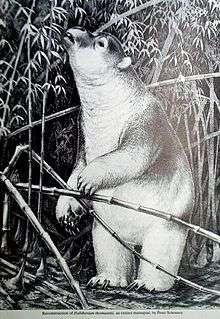Hulitherium
| Hulitherium Temporal range: Pleistocene | |
|---|---|
 | |
| Restoration of Hulitherium | |
| Scientific classification | |
| Kingdom: | Animalia |
| Phylum: | Chordata |
| Class: | Mammalia |
| Infraclass: | Marsupialia |
| Order: | Diprotodontia |
| Suborder: | Vombatiformes |
| Family: | Zygomaturidae |
| Genus: | Hulitherium Flannery & Plane, 1986 |
| Species: | H. tomasetti |
| Binomial name | |
| Hulitherium tomasetti Flannery & Plane, 1986 | |
Hulitherium tomasetti (meaning "Huli beast", after the Huli people)[1] is an extinct zygomaturid marsupial from New Guinea during the Pleistocene. The species name honours Bernard Tomasetti who brought the fossils to the attention of experts.[1]
Fossils
Hulitherium was described on the basis of a nearly complete skull, several detached teeth, a fragment of lower jaw, atlas and cervical vertebrae, almost complete humerus and fragmentary bones of the hind limb. The skeleton suggests that the limbs were highly mobile relative to the other diprotodontids and that it was a browser.[1]
Biology
Hulitherium lived in montane rain forests and may have fed on bamboo. perhaps a marsupial analogue of the giant panda. It was one of New Guinea's largest mammals with the height of 1 m (3 ft) and was close to 2 m (6 ft) long. And the estimated weight of 75-200 kilograms. Flannery and Plane (1986) suggested that because little had changed since the Late Pleistocene, humans may have been the major factor that led to its extinction.[1]
Other relatives
Murray (1992) concluded that Hulitherium is most closely related to the New Guinean Maokopia, and that these two together are most closely related to Kolopsis rotundus also from new Guinea. Black and Mackness(1999) suggested that the Hulitherium clade is more closely related to the clade comprising Zygomaturus plus another undescribed genus from Australia, than it is to Kolopsis.[1]
References
- 1 2 3 4 5 Long, J.; Archer, M.; Flannery, T.; Hand, S. (2002). Prehistoric Mammals of Australia and New Guinea: One Hundred Million Years of Evolution. The Johns Hopkins University Press. p. 91. ISBN 0-8018-7223-5. OCLC 49860159.
Sources
- David Norman. (2001): The Big Book Of Dinosaurs. Pg.133, Welcome Books.
- Wildlife of Gondwana: Dinosaurs and Other Vertebrates from the Ancient Supercontinent (Life of the Past) by Pat Vickers Rich, Thomas Hewitt Rich, Francesco Coffa, and Steven Morton
- Australia's Lost World: Prehistoric Animals of Riversleigh by Michael Archer, Suzanne J. Hand, and Henk Godthelp
- Classification of Mammals by Malcolm C. McKenna and Susan K. Bell
- Extinctions in Near Time: Causes, Contexts, and Consequences (Advances in Vertebrate Paleobiology) by Ross D.E. MacPhee and Hans-Dieter Sues
See also
| Wikispecies has information related to: Hulitherium |